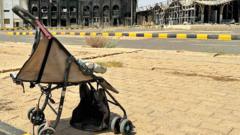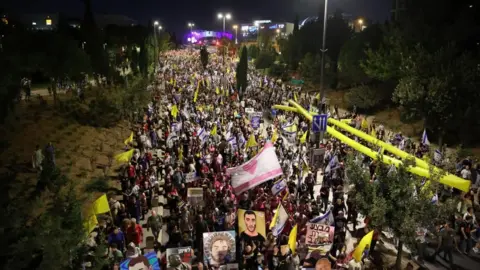The once-vibrant city of Khartoum now echoes the somber aftermath of a brutal six-month conflict as the Sudanese army has regained control from the paramilitary Rapid Support Forces (RSF). Days after the military's decisive victory, the city presents a haunting landscape where urban warfare has transformed the commercial and governmental heart of Sudan into a desolate shell.
The offensive, which has spanned two years, is believed to have claimed over 150,000 lives amid escalating tensions between the army and the RSF. While people take to the streets to celebrate Eid—a festival marking the end of Ramadan—questions loom over the future of this battered capital.
Our exploration through the city led us to the presidential palace, a symbolic stronghold occupied by the RSF for much of the conflict. The interior is littered with debris; remnants of its former grandeur now obscured by dust, shattered glass, and visible signs of looting. Chairs and art pieces remain, but vital infrastructure, including electrical systems, has been ruthlessly stripped. An army soldier accompanying us expressed a sense of honor returning to the palace, highlighting its strong connection to Sudanese identity and dignity.
As celebrations unfolded nearby, the mood was subdued by the heavy toll of war. Streets are lined with the aftermath—burned offices, government buildings, and remnants of aircraft littering the airport runway. Caution is paramount; unexploded ordnance still rests silently on traversed roads amidst grim finds of human remains.
Among the few undamaged structures was St Matthew's Cathedral, offering a brief respite from devastation. Its facade stands in contrast to the surrounding destruction; the church has suffered shelling yet remains relatively intact, embodying a sacred space that survived the siege. Nearby, a soldier reflected on the desecration of the church during conflict, revealing the additional layer of strife.
In the months preceding this army victory, the fighting forced many residents to evacuate while embassies suffered extensive damage, questioning their ability to aid during a time of crisis. In stark contrast to the silent streets of Khartoum, together with its extensive hardships, Eid celebrations signified a turning point for many residents, who embraced freedom with trepidation and joy.
Among the excited crowds, stories of hardship mingle with hope. Osman al-Bashir, a local activist, described the emotional release he felt, noting a newfound sense of life and community. For Duaa Tariq, who has advocated for democracy alongside a return to civil governance post-revolution, the contrasts of war remain vivid. Despite potential threats to hard-won freedoms, this moment of celebration offers a chance to dream of recovery.
Lamenting losses while seeking a better tomorrow, residents expressed hopes for international investment to facilitate reconstruction. Yet there’s a collective consciousness that the scars of conflict have deeply marked their psyche, and many share a united concern for the fate of youth traumatized by war.
As families perspective reshape, the lament for what was lost continues to shadow this newfound breath of freedom. Hopes linger for a smooth transition back towards normalcy, but the uncertainty ahead remains palpable. Through the shared prayers of Khartoum’s citizens, there’s a gentle voice of hope calling for protection and stability, especially for those in conflict-ridden areas like Darfur.
The landscape of Khartoum may be scarred and its people weary yet resilient; they stand at the precipice of rebuilding while grappling with the remnants of strife that could shape their country's future for years to come.


















